Sustainable Vehicles-Based Alternatives in Last Mile Distribution of Urban Freight Transport: A Systematic Literature Review
Abstract
:1. Introduction
2. Methodology and Research Protocol
3. Systematic Literature Review on Last Mile Distribution
3.1. Research Synthesis
3.2. Analysis
4. Conclusions
Author Contributions
Conflicts of Interest
References
- McKinnon, A.C.; Browne, M.; Whiteing, A.E. Green Logistics : Improving the Environmental Sustainability of Logistics; Kogan Page Publishers: London, UK, 2015. [Google Scholar]
- Oliveira, C.M.; D’Agosto, M.D.A.; Mello, A.L.D.d.; Assumpção, F.D.C.; Gonçalves, F.D.S.; Gonçalves, D.N.S. Identificando os desafios e as boas práticas para o transporte urbano de cargas, por meio de uma revisão bibliográfica sistemática. Transportes 2016, 24, 9. [Google Scholar] [CrossRef]
- Muñoz-Villamizar, A.; Montoya-Torres, J.R.; Faulin, J. Impact of the use of electric vehicles in collaborative urban transport networks: A case study. Transp. Res. D Trans. Environ. 2017, 50, 40–54. [Google Scholar] [CrossRef]
- Björklund, M.; Gustafsson, S. Toward sustainability with the coordinated freight distribution of municipal goods. J. Clean. Prod. 2015, 98, 194–204. [Google Scholar] [CrossRef]
- Roumboutsos, A.; Kapros, S.; Vanelslander, T. Green city logistics: Systems of innovation to assess the potential of e-vehicles. Res. Transp. Bus. Manag. 2014, 11, 43–52. [Google Scholar] [CrossRef]
- Joerss, M.; Schröder, J.; Neuhaus, F.; Klink, C.; Mann, F. Mckinsey & company parcel delivery: The future of last mile. McKinsey & Company: Travel, Transport Logist. 2016. Available online: http://www.mckinsey.com/industries/travel-transport-and-logistics/our-insights/how-customer-demands-are-reshaping-last-mile-delivery (accessed on 26 July 2017).
- Sanchez Rodrigues, V.; Piecyk, M.; Mason, R.; Boenders, T. The longer and heavier vehicle debate: A review of empirical evidence from germany. Transp. Res. D Trans. Environ. 2015, 40, 114–131. [Google Scholar] [CrossRef]
- Steadieseifi, M.; Dellaert, N.P.; Nuijten, W.; Van Woensel, T.; Raoufi, R. Multimodal freight transportation planning: A literature review. Eur. J.Oper. Res. 2014, 233, 1–15. [Google Scholar] [CrossRef]
- Urban Freight Research Roadmap. 2014. Brussel, Belgium. Available online: http://www.ertrac.org/uploads/documentsearch/id36/ERTRAC_Alice_Urban_Freight.pdf (accessed on 26 July 2017).
- Winkenbach, M.; Roset, A.; Spinler, S.; Winkenbach, M.; Roset, A.; Spinler, S. Strategic redesign of urban mail and parcel networks at la poste strategic redesign of urban mail and parcel networks at la poste. Interfaces 2016, 46, 445–458. [Google Scholar] [CrossRef]
- Lee, H.L.; Chen, Y.; Gillai, B.; Rammohan, S. Technological Disruption and Innovation in Last-mile Delivery. Available online: https://www.gsb.stanford.edu/sites/gsb/files/publication-pdf/vcii-publication-technological-disruption-innovation-last-mile-delivery.pdf (accessed on 26 July 2017).
- Rowley, J.; Slack, F. Conducting a literature review. Mang. Res. News 2004, 27, 31–39. [Google Scholar] [CrossRef]
- Cook, D.J.; Mulrow, C.D.; Haynes, R.B. Systematic reviews: Synthesis of best evidence for clinical decisions. Ann. Intern. Med. 1997, 126, 376–380. [Google Scholar] [CrossRef] [PubMed]
- Brereton, P.; Kitchenham, B.A.; Budgen, D.; Turner, M.; Khalil, M. Lessons from applying the systematic literature review process within the software engineering domain. J. Syst. Softw. 2007, 80, 571–583. [Google Scholar] [CrossRef]
- Tranfield, D.; Denyer, D.; Smart, P. Towards a methodology for developing evidence-informed management knowledge by means of systematic review* introduction: The need for an evidence- informed approach. Br. J. Manag. 2003, 14, 207–222. [Google Scholar] [CrossRef]
- Thomé, A.M.T.; Scavarda, L.F.; Scavarda, A.J. Conducting systematic literature review in operations management. Prod. Plann. Contr. 2016, 27, 408–420. [Google Scholar] [CrossRef]
- Nord, J.H.; Nord, G.D. Mis research: Journal status assessment and analysis. Inform. Manag. 1995, 29, 29–42. [Google Scholar] [CrossRef]
- Ngai, E.W.T.; Wat, F.K.T. A literature review and classification of electronic commerce research. Inform. Manag. 2002, 39, 415–429. [Google Scholar] [CrossRef]
- Torraco, R.J. Writing integrative literature reviews: Guidelines and examples. Hum. Resource Dev. Rev. 2005, 4, 356–367. [Google Scholar] [CrossRef]
- Nielsen, L. Classifications of Countries Based on Their Level of Development: How It is Done and How It Could be Done. IMF Working Paper. 2011. Available online: https://www.imf.org/en/Publications/WP/Issues/2016/12/31/Classifications-of-Countries-Basedon-their-Level-of-Development-How-it-is-Done-and-How-it-24628 (accessed on 26 July 2017).
- Tozzi, M.; Corazza, M.V.; Musso, A. Recurring patterns of commercial vehicles movements in urban areas: The parma case study. Procedia–Soc. Behav. Sci. 2013, 87, 306–320. [Google Scholar] [CrossRef]
- Lebeau, P.; Macharis, C.; van Mierlo, J.; Maes, G. Implementing electric vehicles in urban distribution: A discrete event simulation. WEVJ 2013, 6, 38–47. [Google Scholar]
- Sadhu, S.L.N.S.; Tiwari, G.; Jain, H. Impact of cycle rickshaw trolley (crt) as non-motorised freight transport in delhi. Transport Policy 2014, 35, 64–70. [Google Scholar] [CrossRef]
- Visser, J.; Nemoto, T.; Browne, M. Home delivery and the impacts on urban freight transport: A review. Procedia–Soc. Behav. Sci. 2014, 125, 15–27. [Google Scholar] [CrossRef]
- Gruber, J.; Kihm, A.; Lenz, B. A new vehicle for urban freight? An ex-ante evaluation of electric cargo bikes in courier services. Res. Transp. Bus. Manag. 2014, 11, 53–62. [Google Scholar] [CrossRef] [Green Version]
- Foltyński, M. Electric fleets in urban logistics. Procedia–Soc. Behav. Sci. 2014, 151, 48–59. [Google Scholar] [CrossRef]
- Oliveira, L.; Regina Pinto Oliveira, B.; de Assis Correia, V. Sciencedirect simulation of an urban logistic space for the distribution of goods in belo horizonte, brazil. Procedia–Soc. Behav. Sci. 2014, 125, 496–505. [Google Scholar] [CrossRef]
- Montwiłł, A. The role of seaports as logistics centers in the modelling of the sustainable system for distribution of goods in urban areas. Procedia–Soc. Behav. Sci. 2014, 151, 257–265. [Google Scholar] [CrossRef]
- Diziain, D.; Taniguchi, E.; Dablanc, L. Urban logistics by rail and waterways in france and japan. Procedia–Soc. Behav. Sci. 2014, 125, 159–170. [Google Scholar] [CrossRef]
- Thompson, R.G.; Hassall, K. Implementing high productivity freight vehicles in urban areas. Procedia–Soc. Behav. Sci. 2014, 151, 318–332. [Google Scholar] [CrossRef]
- Schliwa, G.; Armitage, R.; Aziz, S.; Evans, J.; Rhoades, J. Sustainable city logistics—Making cargo cycles viable for urban freight transport. Res. Transp. Bus. Manag. 2014, 15, 50–57. [Google Scholar] [CrossRef]
- Alessandrini, A.; Campagna, A.; Site, P.D.; Filippi, F.; Persia, L. Automated vehicles and the rethinking of mobility and cities. Transp. Res. Procedia 2015, 5, 145–160. [Google Scholar] [CrossRef]
- Faccio, M.; Gamberi, M. New city logistics paradigm: From the “last mile” to the “last 50 miles” sustainable distribution. Sustainability 2015, 7, 14873–14894. [Google Scholar] [CrossRef]
- Lebeau, P.; De Cauwer, C.; Van Mierlo, J.; Macharis, C.; Verbeke, W.; Coosemans, T. Conventional, hybrid, or electric vehicles: Which technology for an urban distribution centre? Sci. World J. 2015, 2015, 2–11. [Google Scholar] [CrossRef] [PubMed]
- Andaloro, L.; Napoli, G.; Sergi, F.; Micari, S.; Agnello, G.; Antonucci, V. Development of a new concept electric vehicle for last mile transportations. Proceedings of EVS28 28th International Electric Vehicle Symposium and Exhibition, Goyang, South Korea, 2015. [Google Scholar]
- Dampier, A.; Marinov, M. A study of the feasibility and potential implementation of metro-based freight transportation in newcastle upon tyne. Urban Rail Transit 2015, 1, 164–182. [Google Scholar] [CrossRef]
- Schau, V.; Rossak, W.; Hempel, H.; Spathe, S. Smart city logistik erfurt (scl): Ict-support for managing fully electric vehicles in the domain of inner city freight traffic: A look at an ongoing federal project in the City of Erfurt, Erfurt, Germany. Proceedings of IEOM 2015–5th International Conference on Industrial Engineering and Operations Management, Dubai, United Arab Emirates, 2015. [Google Scholar]
- Margaritis, D.; Anagnostopoulou, A.; Tromaras, A.; Boile, M. Electric commercial vehicles: Practical perspectives and future research directions. Res. Transp. Bus. Manag. 2016, 18, 4–10. [Google Scholar] [CrossRef]
- Navarro, C.; Roca-Riu, M.; Furió, S.; Estrada, M. Designing new models for energy efficiency in urban freight transport for smart cities and its application to the spanish case. Transp. Res. Procedia 2016, 12, 314–324. [Google Scholar] [CrossRef] [Green Version]
- Rizet, C.; Cruz, C.; Vromant, M. The constraints of vehicle range and congestion for the use of electric vehicles for urban freight in france. Transp. Res. Procedia 2016, 12, 500–507. [Google Scholar] [CrossRef]
- Gruber, J.; Kihm, A. Reject or embrace? Messengers and electric cargo bikes. Transp. Res. Procedia 2016, 12, 900–910. [Google Scholar]
- Heitz, A.; Beziat, A. The parcel industry in the spatial organization of logistics activities in the paris region: Inherited spatial patterns and innovations in urban logistics systems. Transp. Res. Procedia 2016, 12, 812–824. [Google Scholar] [CrossRef]
- Anderluh, A.; Hemmelmayr, V.C.; Nolz, P.C. Synchronizing vans and cargo bikes in a city distribution network. Cent. Eur. J. Oper. Res. 2016, 25, 1–32. [Google Scholar] [CrossRef]
- Taniguchi, E.; Thompson, R.G.; Yamada, T. New opportunities and challenges for city logistics. Transp. Res. Procedia 2016, 12, 5–13. [Google Scholar] [CrossRef]
- Schier, M.; Offermann, B.; Weigl, J.D.; Maag, T.; Mayer, B.; Rudolph, C.; Gruber, J. Innovative two wheeler technologies for future mobility concepts. Proceedings of 2016 11th International Conference on Ecological Vehicles and Renewable Energies, EVER 2016, Monte Carlo, Monaco, 6 April 2016. [Google Scholar]
- EU: Vehicle Definitions. Transportpolicy.net. Available online: http://transportpolicy.net/index.php?title=EU:_Vehicle_Definitions (accessed on 26 July 2017).
- Schoemaker, J.; Allen, J.; Huschebeck, M.; Monigl, J. Quantification of urban freight transport effects Best Urban Freight Solutions II. 2005. Available online: http://www.bestufs.net/download/BESTUFS_II/key_issuesII/BESTUF_Quantification_of_effects.pdf (accessed on 26 July 2017).
- Dablanc, L. Freight Transport for Development Toolkit: Urban Freight; World Bank: Washington, DC, USA, 2009. [Google Scholar]
- Ferreira, A.F. A utilização de triciclos na distribuição física de bebidas no rio de janeiro. Uma abordagem qualitativa sobre a operação the use of tricycles in the physical distribution of beverages in rio de janeiro city. A qualitative approach of the operation. Available online: www.revistaret.com.br/ojs-2.2.3/index.php/ret/article/view/369 (accessed on 26 July 2017).
- Weiss, M.; Dekker, P.; Moro, A.; Scholz, H.; Patel, M.K. On the electrification of road transportation—A review of the environmental, economic, and social performance of electric two-wheelers. Transp. Res. D Trans. Environ. 2015, 41, 348–366. [Google Scholar] [CrossRef]
- Cox, W.; Pavletich, H. 13th Annual Demographia International Housing Affordability Survey Rating Middle—Income Housing Affordability 2017. Available online: http://www.demographia.com/dhi.pdf (accessed on 26 July 2017).
- Tozzi, M.; Corazza, M.V.; Musso, A. Urban goods movements in a sensitive context: The case of parma. Res. Transp. Bus. Manag. 2014, 11, 134–141. [Google Scholar] [CrossRef]
- Rezvani, Z.; Jansson, J.; Bodin, J. Advances in consumer electric vehicle adoption research: A review and research agenda. Transp. Res. D Trans. Environ. 2015, 34, 122–136. [Google Scholar] [CrossRef]
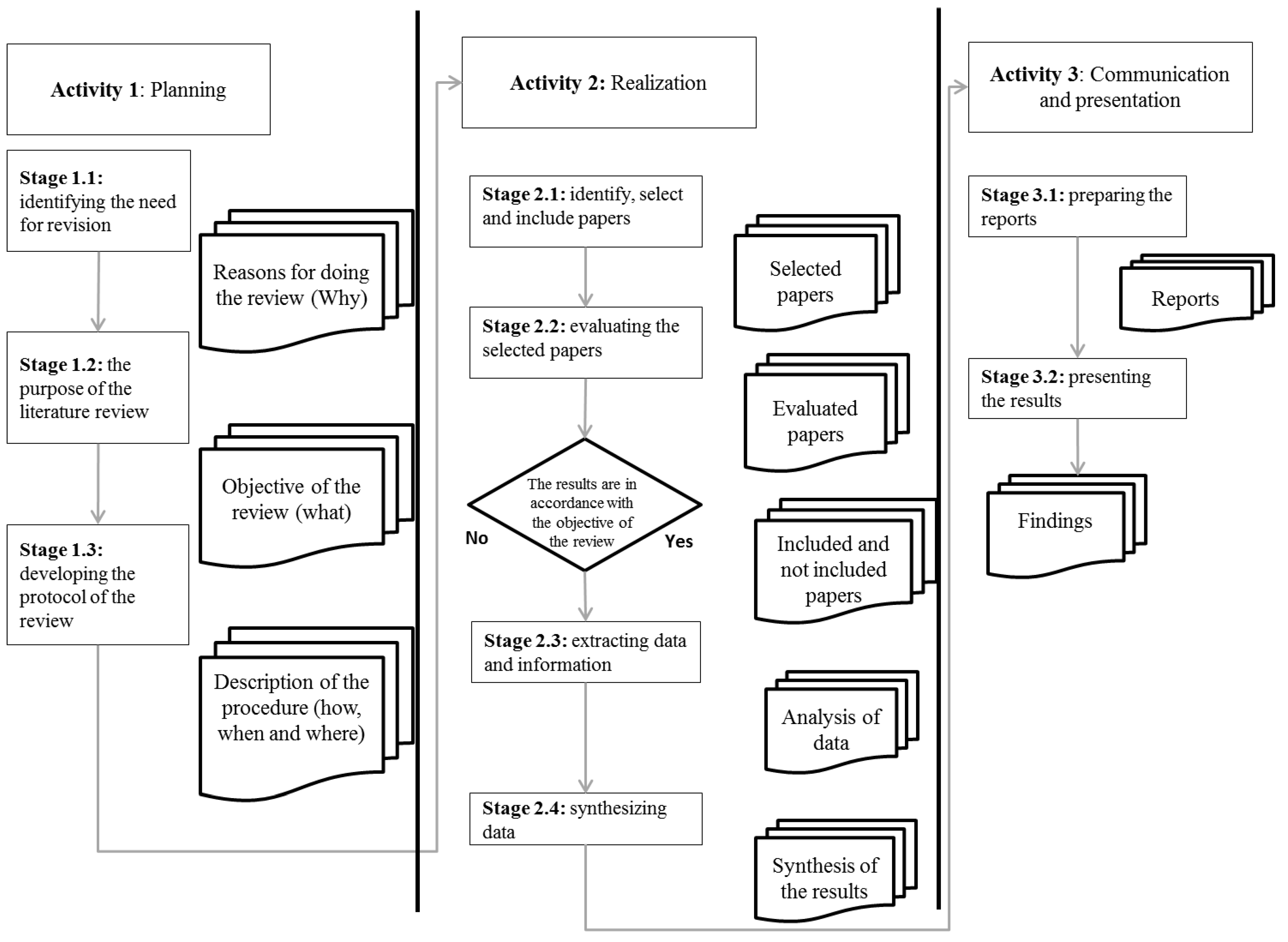

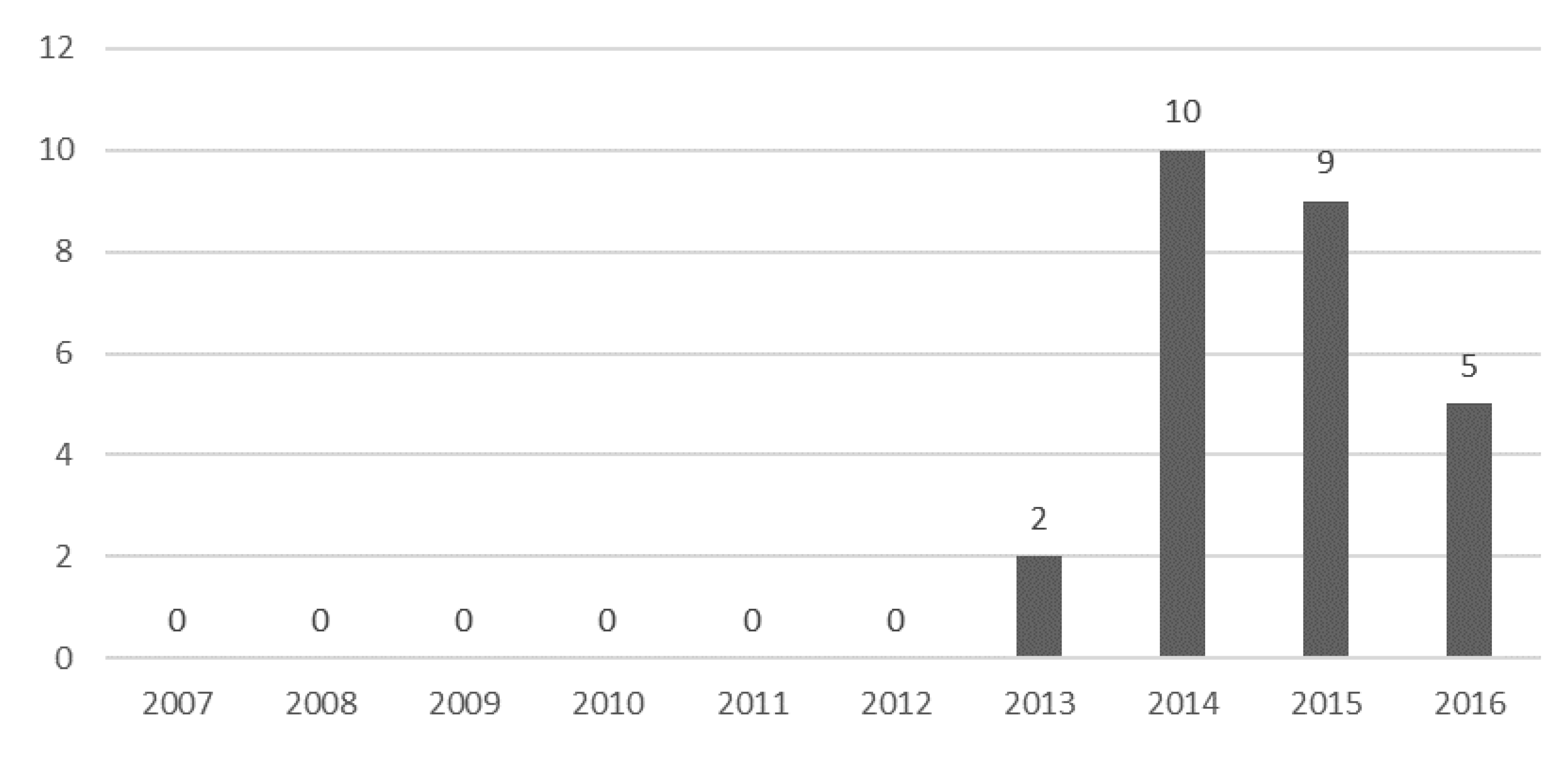
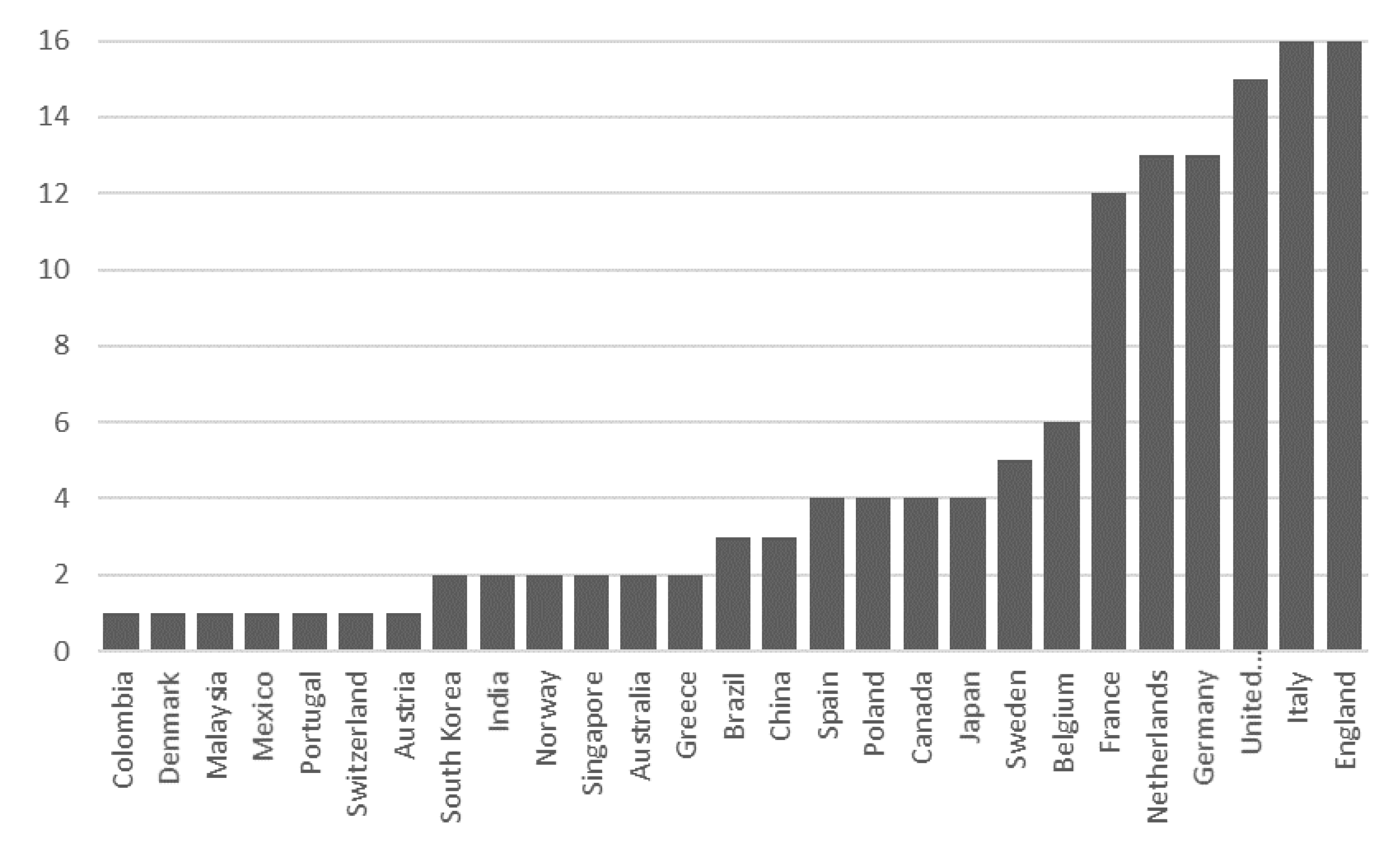
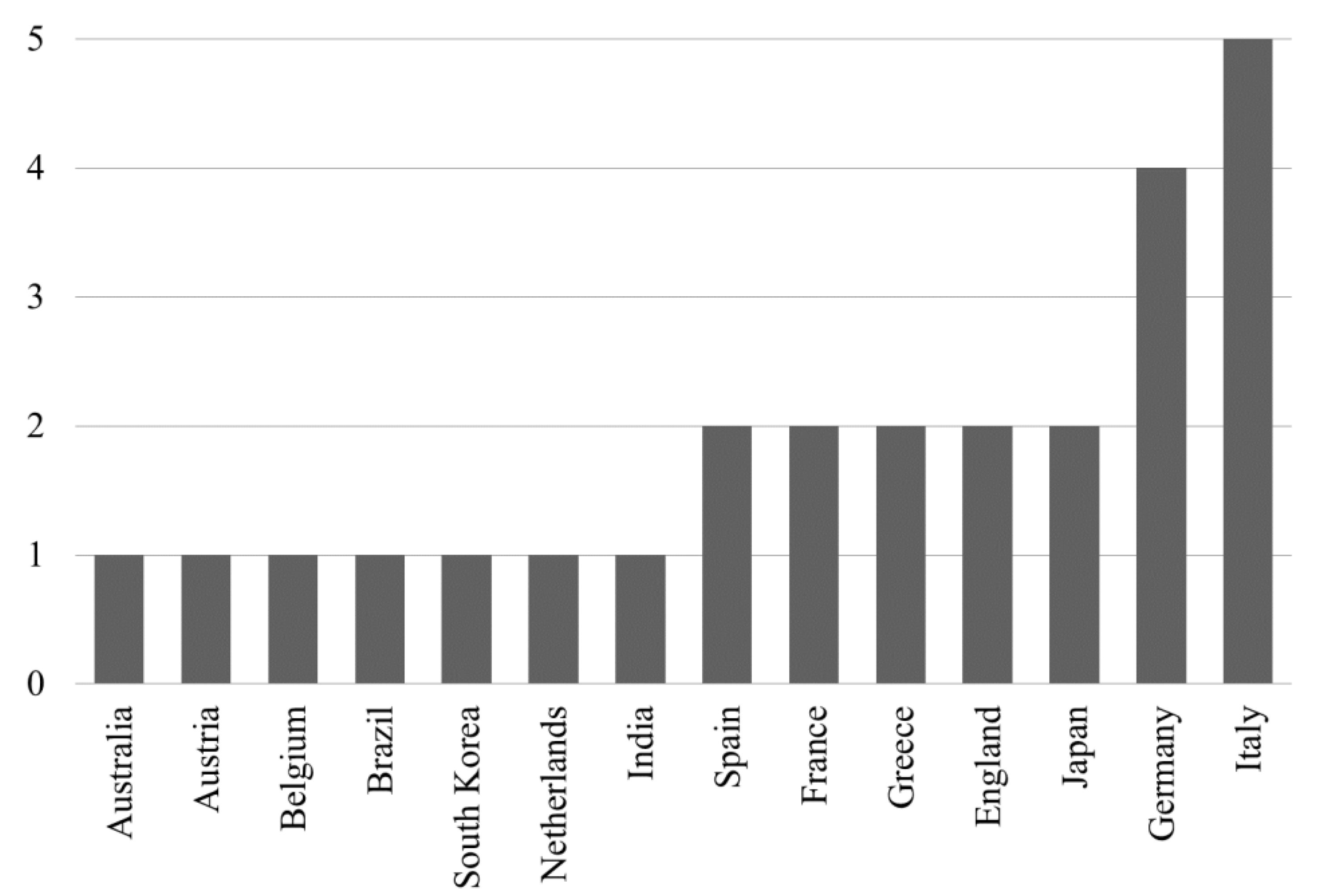
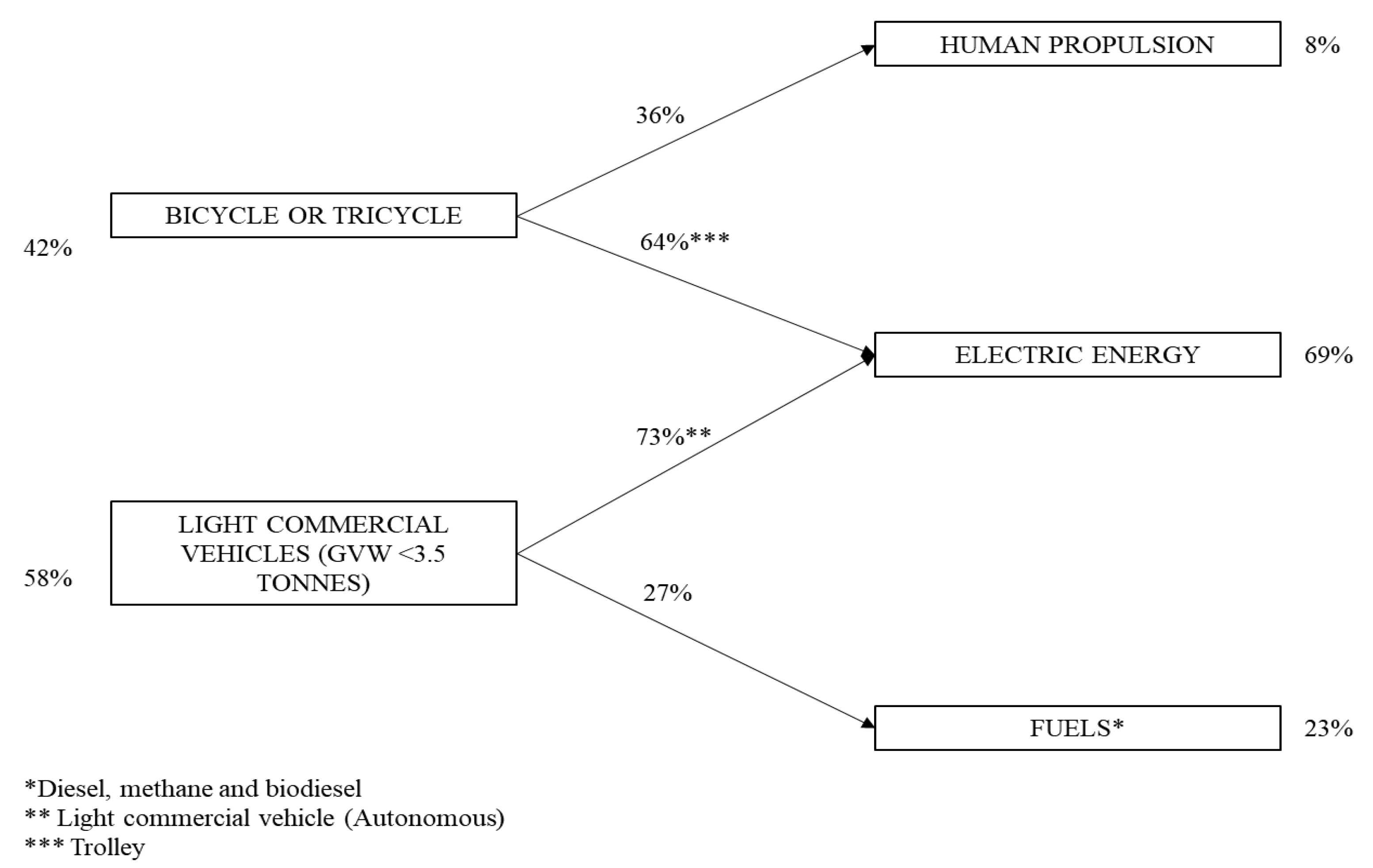
| Database | Identified Papers | After Deleting Duplicates | Selected Papers | Included Papers |
|---|---|---|---|---|
| Science Direct | 108 | 108 | 17 | 17 |
| Web of Science | 12 | 6 | 6 | 2 |
| EBSCO | 2 | 1 | 1 | 0 |
| DOAJ | 7 | 6 | 6 | 0 |
| Scopus | 5 | 4 | 4 | 3 |
| Compendex | 13 | 12 | 12 | 2 |
| Total | 157 | 137 | 46 | 26 |
| Author | Type of Vehicle or Equipment Used | Source of Energy | Barriers | Benefits/Opportunities | ||
|---|---|---|---|---|---|---|
| Economics | Environmental | Social | ||||
| Tozzi et al. [21] | Light commercial | Diesel and Methane (dedicated) | - | - | - | - |
| Lebeau et al. [22] | Light commercial | Electric | Fleet acquisition costs; Capacity (weight and dimensions) | - | Reduction of CO2 emissions and atmospheric pollutants | - |
| Sadhu et al. [23] | Bicycle 1 Tricycle 2 | Human | Customers concerns | Energy consumption; Delivery time; Traffic congestion | Reduction of CO2 emissions and atmospheric pollutants | Job creation/Health problems |
| Visser et al. [24] ** | Light commercial 3 | Diesel and Biodiesel | - | Reduction of CO2 emissions and atmospheric pollutants | Quality of life | |
| Gruber et al. [25] ** | Bicycle / Tricycle | Electric | Road and recharge infrastructure; Customers concerns | Operational cost; Energy consumption; | Reduction of CO2 emissions and atmospheric pollutants | - |
| Roumboutsos et al. [5] | Light commercial | Electric | Operational cost; Recharge infrastructure | - | Reduction of CO2 emissions, atmospheric pollutants and noise | - |
| Foltyński [26] | Trolleys 4/Bicycle/Tricycle, Light commercial and Motorcycles 5 | Electric | - | Traffic congestion | - | - |
| Oliveira et al. [27] ** | Bicycle/Tricycle | Human | - | Delivery time | Reduction of CO2 emissions and atmospheric pollutants | - |
| Montwiłł [28] | Light commercial | Electric | - | - | - | - |
| Diziain et al. [29] | Bicycle/Tricycle | Electric | Cargo consolidation centre; Road and recharge infrastructure | - | Reduction of CO2 emissions and atmospheric pollutants | - |
| Thompson and Hassall [30] | Light commercial | Diesel | - | - | - | |
| Schliwa et al. [31] | Bicycle/Tricycle | Human | Customers concerns; Cargo consolidation centre; Capacity (weight and dimensions) | Energy consumption; Delivery time | Reduction of CO2 emissions and atmospheric pollutants | Job creation |
| Alessandrini et al. [32] | Light commercial (Autonomous) | Electric | Recharge infrastructure | - | Reduction of CO2 emissions and atmospheric pollutants | - |
| Faccio and Gamberi [33] | Light commercial | Electric | - | Operational cost | Reduction of CO2 emissions and atmospheric pollutants | Quality of life |
| Lebeau et al. [34] | Light commercial | Electric | Fleet acquisition costs | - | Reduction of CO2 emissions and atmospheric pollutants | - |
| Andaloro et al. [35] | Light commercial | Electric | Fleet acquisition costs; Capacity (weight and dimensions) | - | Reduction of CO2 emissions and atmospheric pollutants | - |
| Dampier and Marinov [36] | Bicycle/Tricycle | Human | Cargo consolidation centre | Delivery time; Traffic congestion | Reduction of CO2 emissions and atmospheric pollutants | - |
| Schau et al. [37] | Light commercial | Electric | Cargo consolidation centre; Road and recharge infrastructure; Capacity (weight and dimensions); vehicles charging time | - | Reduction of CO2 emissions and atmospheric pollutants | - |
| (Margaritis et al. [38] | Light commercial | Electric | - | - | - | - |
| Navarro et al. [39] ** | Bicycle/Tricycle | Electric | Cargo consolidation centre; Road and recharge infrastructure; Capacity (weight and dimensions) | - | Reduction of CO2 emissions, atmospheric pollutants and noise | - |
| Rizet et al. [40] ** | Light commercial | Electric | Recharge infrastructure (electric) | Traffic congestion | Reduction of CO2 emissions and atmospheric pollutants | - |
| Gruber and Kihm [41] | Bicycle/Tricycle | Electric | - | - | - | - |
| Heitz and Beziat [42] | Bicycle/Tricycle | Electric | Cargo consolidation centre; | Operational cost | Reduction of CO2 emissions and atmospheric pollutants | - |
| Anderluh et al. [43] | Bicycle/Tricycle | Electric | - | Traffic congestion | Reduction of CO2 emissions, atmospheric pollutants and noise | - |
| Taniguchi et al. [44] | Light commercial | Diesel | Cargo consolidation centre | - | Reduction of CO2 emissions, atmospheric pollutants and noise | - |
| Schier et al. [45] | Bicycle/Tricycle | Electric | - | - | Reduction of CO2 emissions and atmospheric pollutants | Quality of life |
| Country | City | Number of citations in papers | Population | Density |
|---|---|---|---|---|
| France | Paris | 3 | 2.2 million inhabitants | 20,980 inhabitants/km2 |
| Spain | Barcelona | 1 | 1.6 million inhabitants | 15,895 inhabitants/km2 |
| Brazil | Belo Horizonte | 1 | 2.5 million inhabitants | 7561 inhabitants/km2 |
| Japan | Tokyo | 2 | 13 million inhabitants | 6354 inhabiants/km2 |
| Spain | Valence | 1 | 792,000 inhabitants | 5844 inhabitants/km2 |
| India | New Delhi | 1 | 250,000 inhabitants | 5720 inhabitants/km2 |
| Netherlands | Amsterdam | 1 | 779,000 inhabitants | 4908 inhabitants/km2 |
| Austria | Vienna | 1 | 1.7 million inhabitants | 4069 inhabitants/km2 |
| Germany | Berlin | 3 | 4.1 million inhabitants | 3848 inhabitants/km2 |
| Italy | Padua | 1 | 210,000 inhabitants | 2267 inhabitants/km2 |
| Germany | Erfurt | 1 | 206,000 inhabitants | 754 inhabitants/km2 |
| England | Newcastle | 1 | 259,000 inhabitants | 719 inhabitants/km2 |
| Italy | Parma | 1 | 178,000 inhabitants | 601 inhabitants/km2 |
| Italy | Lucca | 1 | 87,000 inhabitants | 431 inhabitants/km2 |
| Australia | Sidney | 1 | 4.7 million inhabitants | 391 inhabitants/km2 |
| England | Cambridge | 1 | 123,000 inhabitants | 307 inhabitants/km2 |
© 2017 by the authors. Licensee MDPI, Basel, Switzerland. This article is an open access article distributed under the terms and conditions of the Creative Commons Attribution (CC BY) license (http://creativecommons.org/licenses/by/4.0/).
Share and Cite
Oliveira, C.M.d.; Albergaria De Mello Bandeira, R.; Vasconcelos Goes, G.; Schmitz Gonçalves, D.N.; D’Agosto, M.D.A. Sustainable Vehicles-Based Alternatives in Last Mile Distribution of Urban Freight Transport: A Systematic Literature Review. Sustainability 2017, 9, 1324. https://doi.org/10.3390/su9081324
Oliveira CMd, Albergaria De Mello Bandeira R, Vasconcelos Goes G, Schmitz Gonçalves DN, D’Agosto MDA. Sustainable Vehicles-Based Alternatives in Last Mile Distribution of Urban Freight Transport: A Systematic Literature Review. Sustainability. 2017; 9(8):1324. https://doi.org/10.3390/su9081324
Chicago/Turabian StyleOliveira, Cintia Machado de, Renata Albergaria De Mello Bandeira, George Vasconcelos Goes, Daniel Neves Schmitz Gonçalves, and Márcio De Almeida D’Agosto. 2017. "Sustainable Vehicles-Based Alternatives in Last Mile Distribution of Urban Freight Transport: A Systematic Literature Review" Sustainability 9, no. 8: 1324. https://doi.org/10.3390/su9081324
APA StyleOliveira, C. M. d., Albergaria De Mello Bandeira, R., Vasconcelos Goes, G., Schmitz Gonçalves, D. N., & D’Agosto, M. D. A. (2017). Sustainable Vehicles-Based Alternatives in Last Mile Distribution of Urban Freight Transport: A Systematic Literature Review. Sustainability, 9(8), 1324. https://doi.org/10.3390/su9081324






